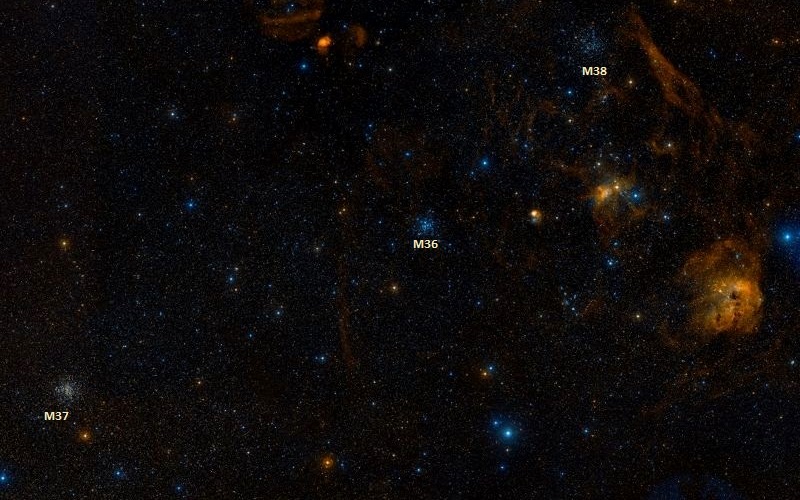Welcome back to Messier Monday! In our ongoing tribute to the great Tammy Plotner, we take a look at the Starfish Cluster, otherwise known as Messier 38. Enjoy!
During the 18th century, famed French astronomer Charles Messier noted the presence of several “nebulous objects” in the night sky. Having originally mistaken them for comets, he began compiling a list of them so that others would not make the same mistake he did. In time, this list (known as the Messier Catalog) would come to include 100 of the most fabulous objects in the night sky.
One of these objects it the Starfish Cluster, also known as Messier 38 (or M38). This open star cluster is located in the direction of the northern Auriga constellation, along with the open star clusters M36 and M37. While not the brightest of the three, the location of the Starfish within the polygon formed by the brightest stars of Auriga makes it very easy to find.
Description:
Cruising around our Milky Way some 4200 light years from our solar system, this 220 million year old group of stars spreads itself across about 25 light years of space. If you’re using a telescope, you may have noticed its not alone… Messier 38 might very well be a binary star cluster! As Anil K. Pandey (et al) explained in a 2006 study:
“We present CCD photometry in a wide field around two open clusters, NGC 1912 and NGC 1907. The stellar surface density profiles indicate that the radii of the clusters NGC 1912 and NGC 1907 are 14′ and 6′ respectively. The core of the cluster NGC 1907 is found to be 1′.6±0′.3, whereas the core of the cluster NGC 1912 could not be defined due to its significant variation with the limiting magnitude. The clusters are situated at distances of 1400±100 pc (NGC 1912) and 1760±100 pc (NGC 1907), indicating that in spite of their close locations on the sky they may be formed in different parts of the Galaxy.”
So what’s happening here? Chances are, when you’re looking at M38, you’re looking at a star cluster that’s currently undergoing a real close encounter! Said M.R. de Oliveira (et al) said in their 2002 study:
“The possible physical relation between the closely projected open clusters NGC 1912 (M 38) and NGC 1907 is investigated. Previous studies suggested a physical pair based on similar distances, and the present study explores in more detail the possible interaction. Spatial velocities are derived from available radial velocities and proper motions, and the past orbital motions of the clusters are retrieved in a Galactic potential model. Detailed N-body simulations of their approach suggest that the clusters were born in different regions of the Galaxy and presently experience a fly-by.”
However, it was Sang Hyun Lee and See-Woo Lee who gave us the estimates of M38’s distance and age. As they wrote in their 1996 study, “UBV CCD Photometry of Open Cluster NGC 1907 and NGC 1912“: “The distance difference of the two clusters is 300pc and the age difference is 150 Myr. These results imply that the two clusters are not physically connected.”
So, how do we know they are two clusters passing in the night? The credit for that goes to de Oliveira and colleagues, who also asserted in their 2002 study:
“These simulations also shows that the faster the clusters approach the weaker the tidal debris in the bridge region, which explain why there is, apparently, no evidence of a material link between the clusters and why it should not be expected. It would be necessary to analyse deep wide field CCD photometry for a more conclusive result about the apparent absence of tidal link between the clusters.”
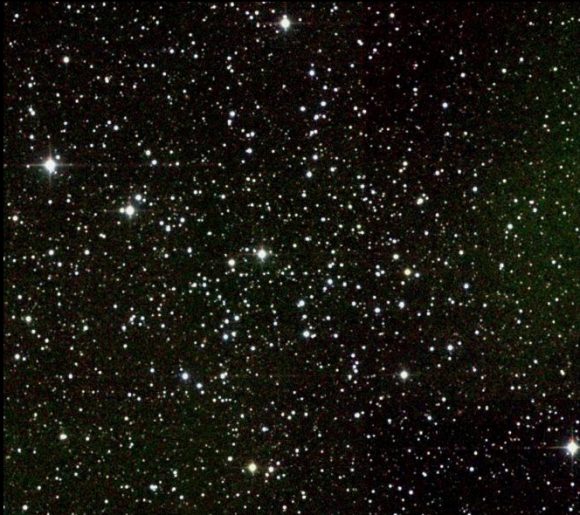
History of Observation:
This wonderful star cluster was originally discovered by Giovanni Batista Hodierna before 1654 and independently rediscovered by Le Gentil in 1749. However, it was Charles Messier’s catalog which brought it to attention:
“In the night of September 25 to 26, 1764, I have discovered a cluster of small stars in Auriga, near the star Sigma of that constellation, little distant from the two preceding clusters: this one is of square shape, and doesn’t contain any nebulosity, if one examines it with a good instrument: its extension may be 15 minutes of arc. I have determined its position: its right ascension was 78d 10′ 12″, and its declination 36d 11′ 51″ north.”
By correcting cataloging its position, M38 could later be studied by other astronomers who would also add their own notes. Caroline, then William Herschel would observe it, where the good Sir William would add to his private notes: “A cluster of scattered, pretty large [bright] stars of various magnitudes, of an irregular figure. It is in the Milky Way.”
Messier Object 38 would then later be added to the New General Catalog by John Herschel, who wasn’t particularly descriptive, either. However, there was an historic astronomer who was determined to examine this star cluster and it was Admiral Symth:
“A rich cluster of minute stars, on the Waggoner’s left thigh, of which a remarkable pair in the following are here estimated. A [mag] 7, yellow; and B 9, pale yellow; having a little companion about 25″ off in the sf [south following, SE] quarter. Messier discovered this in 1764, and described it as ‘a mass of stars of a square form without any nebulosity, extending to about 15′ of a degree;’ but it is singular that the palpable cruciform shape of the most clustering part did not attract his notice. It is an oblique cross, with a pair of large [bright] stars in each arm, and a conspicuous single one at the centre; the whole followed by a bright individual of the 7th magnitude. The very unusual shape of this cluster, recalls the sagacity of Sir William Herschel’s speculations upon the subject, and very much favours the idea of an attractive power lodged in the brightest part. For although the form be not globular, it is plainly to be seen that there is a tendency toward sphericity, by the swell of the dimensions as they draw near the most luminous place, denoting, as it were, a stream, or tide, of stars, setting toward the centre. As the stars in the same nebula must be very merely all at the same relative distance from us, and they appear to be about the same size [brightness], Sir William infers that their real magnitudes must be nearly equal. Granting, therefore, that these nebulae and clusters of stars are formed by their mutual attraction, he concludes that we may judge of their relative age, by the disposition of their component parts, those being the oldest which are the most compressed.”
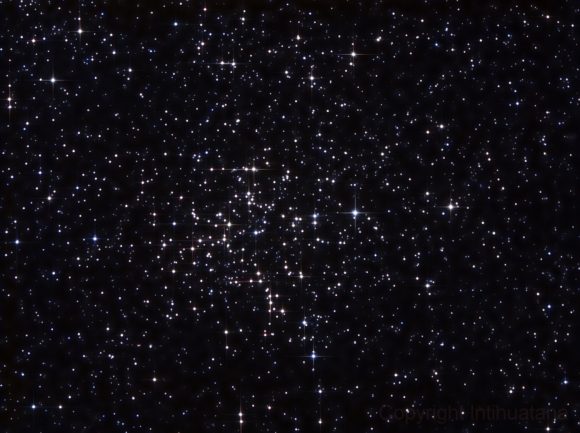
Perhaps by taking his time and really observing, Smyth gained some insight into the true nature of M38! Observe it yourself, and see if you can also locate NGC 1907. It’s quite a pair!
Locating Messier 38:
Locating Messier 38 is relatively easy once you understand the constellation of Auriga. Looking roughly like a pentagon in shape, start by identifying the brightest of these stars – Capella. Due south of it is the second brightest star which shares its border with Beta Tauri, El Nath. By aiming binoculars at El Nath, go north about 1/3 the distance between the two and enjoy all the stars!
You will note two very conspicuous clusters of stars in this area, and so did Le Gentil in 1749. Binoculars will reveal the pair in the same field, as will telescopes using lowest power. The dimmest of these is the M38, and will appear vaguely cruciform in shape. At roughly 4200 light years away, larger aperture will be needed to resolve the 100 or so fainter members. About 2 1/2 degrees to the southeast (about a finger width) you will see the much brighter M36.
More easily resolved in binoculars and small scopes, this “jewel box” galactic cluster is quite young and about 100 light years closer. If you continue roughly on the same trajectory about another 4 degrees southeast you will find open cluster M37. This galactic cluster will appear almost nebula-like to binoculars and very small telescopes – but comes to perfect resolution with larger instruments.
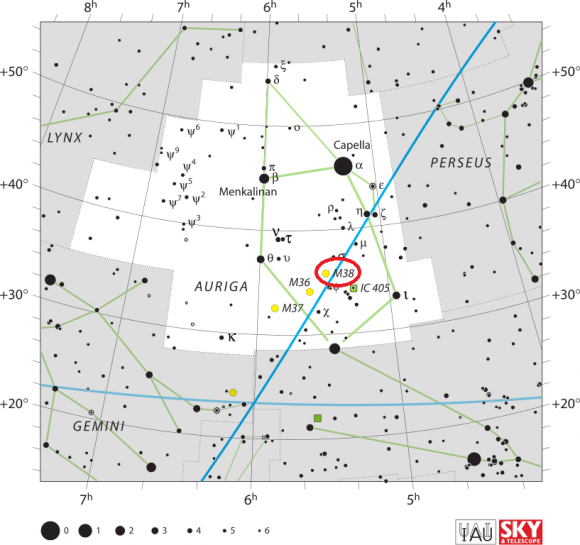
While all three open star clusters make fine choices for moonlit or light polluted skies, remember that high sky light means less faint stars which can be resolved – robbing each cluster of some of its beauty. Messier 38 is faintest and northernmost of the trio and located almost in the center of the Auriga pentagon. Binoculars and small telescopes will easily spot its cross-shaped pattern.
And here are the quick facts on the Starfish Nebula to help you get started:
Object Name: Messier 38
Alternative Designations: M38, NGC 1912
Object Type: Galactic Open Star Cluster
Constellation: Auriga
Right Ascension: 05 : 28.4 (h:m)
Declination: +35 : 50 (deg:m)
Distance: 4.2 (kly)
Visual Brightness: 7.4 (mag)
Apparent Dimension: 21.0 (arc min)
We have written many interesting articles about Messier Objects here at Universe Today. Here’s Tammy Plotner’s Introduction to the Messier Objects, , M1 – The Crab Nebula, M8 – The Lagoon Nebula, and David Dickison’s articles on the 2013 and 2014 Messier Marathons.
Be to sure to check out our complete Messier Catalog. And for more information, check out the SEDS Messier Database.
Sources:

